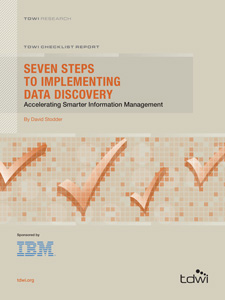
TDWI Checklist Report // Seven Steps to Implementing Data Discovery
September 19, 2011
In many organizations, the speed with which data volumes are growing is outpacing IT’s knowledge of the data. Mergers, acquisitions, new sales channels, and other business restructuring bring in new data sources, but these potential crown jewels of information often turn into a jumbled, chaotic mess that is hard to leverage as an integrated whole. Financial reporting and strategically important projects grind to a halt because users and analysts are uncertain about the new data’s consistency, quality, and completeness.
Data managers struggle to understand what data they have, both within single sources and across disparate sources, and they lack knowledge about the locations of related data elements. For regulatory compliance, they need to know who is using sensitive data so that they can determine what must be done to protect it. However, with the growing size and complexity of data sources, organizations are finding that manual efforts to understand data and map data relationships have become far too time-consuming, if not impossible, to perform. Saddled with incomplete or nonexistent data documentation, organizations have had to depend on the “tribal knowledge” held by a few experienced application developers or power users.
Data discovery tools and methods can help organizations uncover how different data items are related within and across multiple sources. This Checklist Report will help organizations take steps to implement data discovery as the first phase of their quest to accelerate and improve data knowledge. The report examines the role of data discovery in meeting critical information management objectives for understanding data quality and enabling master data management (MDM), data consolidation, and sensitive data protection.